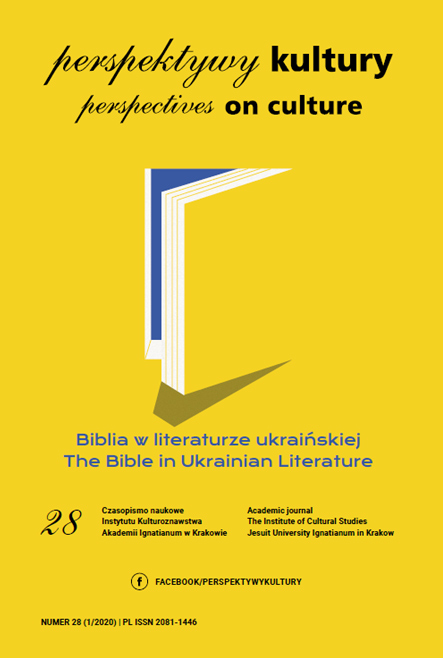The Artistic Reception of the Bible Legend about Cain and Abel in Modern Ukrainian Literature
Abstract
The article investigates the reception of the biblical tale of Cain and Abel in the story by A. Zabuzhko Kazka pro kalinovu sopilku (The tale of Cain’s Flute) and the poem by O. Irvanec, Braty (Brothers). The subject of the study were the forms and methods of interpreting traditional motifs and images.
The biblical legend, its folklore and literary interpretations were selected as the basis for the considerations (J.H. Byron, I. Franko). Following an anti-religious trend in the treatment of traditional images, the authors created a postmodern version of Cain - a murderer and victim at the same time. The material of the Cainic tale also served the writers to address the issue of the relationship between extraordinary personalities and the average ones, and the lesser value of the first in the eyes of God. The result of the study are conclusions about the nature of postmodern reinterpretation of literary tradition in the works of A. Zabuzhko and O. Irvanec.
References
Ahyeyeva, V. (2003). Zhinochyj prostir. Feministychnyj dyskurs ukrayins’koho modernizmu. Kyiv.
Byron, G. (2002). Cain. Blackmask Online, p. 5. http://www.searchengine. org.uk/ebooks/18/38.pdf 8.
Franko, I. (1978). Smert’ Kajina in Zibrannya tvoriv u 50 tomax. Vol. 12, Poe¬tychni pereklady ta perespivy. Kyiv.
Irvanec, O. (1991). Tin’ velykoho klasyka’ ta inshi virshi. Kyiv: Molod.
Vardevanyan, S. I. (2008). Mifolohema Kayina v ukrayins”kij literaturi XIX– XX stolit. Doctoral candidate abstract: 10.01.01. Ivano-Frankivsk.
Zabuzhko, O. (2004). Kazka pro kalinovu sopilku. In Sestro, sestro. Kyiv: Fakt.
Copyright (c) 2020 Jesuit University Ignatianum in Krakow

This work is licensed under a Creative Commons Attribution-NoDerivatives 4.0 International License.
Autor, zgłaszając swój artykuł, wyraża zgodę na korzystanie przez Wydawnictwo Uniwersystet Ignatianum z utworu na następujących polach eksploatacji:
- utrwalania utworu w formie papierowej, a także na nośniku cyfrowym lub magnetycznym;
- zwielokrotnienia utworu dowolną techniką, bez ograniczenia ilości wydań i liczby egzemplarzy;
- rozpowszechniania utworu i jego zwielokrotnionych egzemplarzy na jakimkolwiek nośniku, w tym wprowadzenia do obrotu, sprzedaży, użyczenia, najmu;
- wprowadzenia utworu do pamięci komputera;
- rozpowszechniania utworu w sieciach informatycznych, w tym w sieci Internet;
- publicznego wykonania, wystawienia, wyświetlenia, odtworzenia oraz nadawania i reemitowania, a także publicznego udostępniania utworu w taki sposób, aby każdy mógł mieć do niego dostęp w miejscu i czasie przez siebie wybranym.
Wydawca zobowiązuje się szanować osobiste prawa autorskie do utworu.





